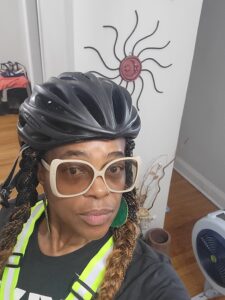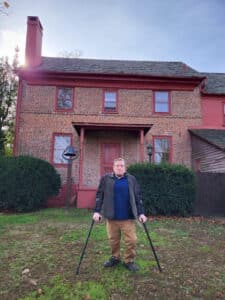Bicycle riders and pedestrians scored a significant victory last week in the ADA-compliant improvements that were included in the Port Authority’s suspender rope/cable replacement project and approved at the PA’s March 19, 2014 Board of Commissioners meeting. As NJBWC led this advocacy effort on behalf of cyclists on both sides of the river, we were the first to offer our testimony at the meeting.
This victory comes on the heels of years of advocacy by the Bicycle Touring Club of North Jersey, Transportation Alternatives, and more recently, NJBWC and New York Cycle Club. The improvements include the elimination of all 171 steps and 6+ staircases that literally plague a crossing of the north path, and replacement with AASHTO-compliant ramps, so that the shared use path on the bridge is completely accessible by bicycle. Also included is the removal of the south hairpin, or “noodle”, as some riders refer to it, on the Manhattan side of the bridge; that ramp will be replaced with an AASHTO-compliant ramp. A suicide screen, new sidewalks and a new lighting system complete the package. These improvements add $56 million to the cost of the overall suspender rope project.
While there have been a few critics who maintain that the paths that are actually on the bridge should have been widened to meet current (2012) AASHTO guidelines, the overwhelming majority is incredibly positive. The feedback to NJBWC in response to our announcement continues to pour in.
The price tag for bridge path widening is an additional $90 million. There are also significant structural constraints that limit what the Port Authority can do. NJBWC has spoken with several experts in the field, and they have voiced their concern that, due to substantial wind loads, adding cantilevered walkways/bikeways to the GWB would inflict an asymmetric load to the middle span. Adding these extensions to both sides of the bridge would be akin to adding wings to the structure. A conservative engineer would likely not make this recommendation.
The FHWA issued guidance last August that advised transportation agencies to “use flexibility” when making design decisions. In other words, individual circumstances can dictate how stringently an agency is able to follow federal guidelines. Based on FHWA’s memo, the PA’s decision not to follow AASHTO on the bridge’s actual pathways falls under this leeway.
There’s likely not a cyclist on either side of the Hudson who would object to additional lane width on the actual pathways. But given these structural and budgetary constraints, it is time to think of Plan B for accommodating long-term growth in the number of bicycle riders using the GWB. In ten years, when this project is fully completed and both pathways are open, the PA may designate one side for cyclists, the other for pedestrians. If capacity eventually outgrows the 8 foot wide shared use path, then the conversation will likely change to identify which of the bridge travel lanes can be designated for cyclists, and at what hours. Imagine a GWB that has a green lane painted along the span in both directions. Add a movable barrier vis a vis the current Tappan Zee Bridge configuration, and you’ve got a flexible use bridge, geared to accommodate heavy vehicular traffic during peak weekly usage, and heavy cycling traffic during the weekend.
If cyclist volume during weekly rush hour does, in fact, reach a level that the paths cannot accommodate, then that movable barrier stops moving and becomes a permanent structure between the green lanes and the car travel lanes. Cyclists will take their place on the roadbed of the GWB, heralding a day when alternative transportation is no longer alternative, and likely forcing several issues, such as the NYC congestion tax that narrowly missed passage, or increased tolls for those who continue to choose to drive a car across the GWB. Imagine that our existing transportation infrastructure actually forces these issues.
NYC’s transportation landscape has changed dramatically in the last 10 years, to a degree unimaginable before it all began. In the next 10 – 20 years, painting a green bicycle lane in both directions of the GWB roadbed may not even make the evening news.
Currently, 300,000 cars drive across the GWB every day. Let’s work towards a day when the PA expresses that number not in cars, but in people.
We consider this a huge win for cyclists, as we got everything we asked for and then some. We look forward to continuing our productive collaboration with the Port Authority.
Cyndi Steiner
Executive Director, New Jersey Bike + Walk Coalition
One of the many staircases on the north path. Note the metal rail, added by the PA in years past to assist cyclists.
Photo by Richard Koppel















































































